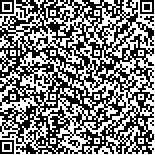| Quote
: |
谢长飞,黄笑梅,杨涛.脂肪肝常见中医证型与生化指标的关系分析[J].湖南中医药大学学报英文版,2018,38(3):296-301.[Click to copy
] |
|
| |
|
|
| This paper
:Browser 3193times Download 986times |
| 脂肪肝常见中医证型与生化指标的关系分析 |
| 谢长飞,黄笑梅,杨涛 |
| (荆州市中医医院, 湖北 荆州 434000;华中科技大学同济医学院, 湖北 武汉 430074) |
| 摘要: |
| 目的 探讨常见五种证型不同程度(轻度、中度和重度)脂肪肝与临床指标的关系。方法 选择2014年9月-2016年11月收治的脂肪肝患者208例,按照中医辨证分为肝郁脾虚证68例、湿浊内停证37例、湿热蕴结证47例,脾肾两虚证31例以及痰瘀互结证25例,同期选择健康对照组60例,比较轻度、中度、重度脂肪肝与中医证型之间的占比关系及相关生化指标与中医证型之间的联系。结果 脂肪肝程度从轻到重排序:肝郁脾虚证→湿热蕴结证→湿浊内停证→脾肾两虚证→痰瘀互结证。轻度脂肪肝湿浊内停证中TC、ALT指标外,其余生化指标与对照组比较均明显升高(P<0.05);四项生化指标(TC、TG、ALT、HOMA-IR)在各中医证型间比较也存在显著差异,痰瘀互结证、脾肾两虚证的TC、TG与其它三证型比较差异具有统计学意义(P<0.05),痰瘀互结证与TC(r=0.14,P=0.00)、TG(r=0.13,P=0.01)有显著相关性;痰瘀互结证、湿热蕴结证ALT升高较其他三证型明显,痰瘀互结证与ALT(r=0.11,P=0.02)有显著相关性;湿热内蕴型HOMA-IR较其它四证型升高明显,湿热内蕴证与HOMA-IR(r=0.14,P=0.02)有显著相关性;痰瘀互结证患者HGB指标有80%高于正常值,湿热蕴结证有72.34%高于正常值,与其它三证比较占比率上升。结论 脂肪肝中医证型与生化指标具有相关性,生化指标的检查结果能有效地帮助临床进行分型诊断,能够为患者病情的发展以及预后提供客观的指标。 |
| 关键词: 脂肪肝 中医证型 生化指标 脂肪肝程度 |
| DOI:10.3969/j.issn.1674-070X.2018.03.016 |
| Received:October 09, 2017 |
| 基金项目:荆州市科学技术局荆科技发项目(201316-54)。 |
|
| Analysis of the Relationship Between the Common TCM Syndrome Types and the Biochemical Indexes of Fatty Liver |
| XIE Changfei,HUANG Xiaomei,YANG Tao |
| (Jingzhou Hospital of Traditional Chinese Medicine, Jingzhou, Hubei 434000, China;Tongji Medical College, Huazhong University of Science and Technology, Wuhan, Hubei 430074, China) |
| Abstract: |
| Objective To investigate the relationship between five different degrees (mild, moerate and severe) of fatty liver and clinical indexes. Methods The 208 cases of fatty liver patients from September 2014 to November 2016 were selected including 68 cases of liver depression and spleen deficiency syndrome, 37 cases of dampness turbidity stagnation syndrome, 47 cases of accumulation of damp heat syndrome, 31 cases of spleen-kidney deficiency syndrome, 25 cases of stagnation of phlegm syndrome. At the same time, 60 healthy persons were selected. The correlation between proportion of mild, moderate, severe fatty liver, and biochemical indexes with TCM syndrome types were compared. Results The degree of fatty liver from mild to severe:liver depression and spleen deficiency syndrome, accumulation of damp heat syndrome, spleen-kidney deficiency syndrome, stagnation of phlegm syndrome. The indicators excepting TC, ALT in mild fatty liver with dampness turbidity stagnation syndrome were statistically higher than those in the control group. The four biomedical indices (TC, TG, ALT,HOMA-IR) among TCM syndrome types were statistically different; TC and TG in patients with liver depression and spleen deficiency syndrome, compared with other three syndrome types, were statistically significant (P<0.05). The stagnation of phlegm syndrome showed positive correlation with TC (r=0.14, P=0.00) and TG (r=0.13, P=0.01). The ALT in patients with stagnation of phlegm syndrome and accumulation of damp heat syndrome were statistically higher than other three syndrome types, and stagnation of phlegm syndrome showed obvious correlation with ALT (r=0.11, P=0.02). The 80% of HGB indicators in patients with stagnation of phlegm syndrome were higher than the nomal indicators, and 72.34% of indicators in patients with accumulation of damp heat syndrome were higher than the normal indicators. Conclusion TCM Syndromes of fatty liver show some correlations with biochemical indexes. The examination results of biochemical indexes could effectively help clinical classification diagnosis, and it could provide objective indicators for the development and prognosis of the patient's condition. |
| Key words: fatty liver TCM syndromes biochemical indicators degree of fatty liver |
|

二维码(扫一下试试看!) |
|
|
|
|


